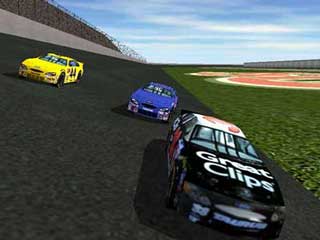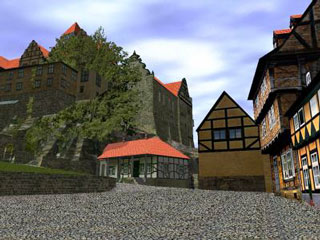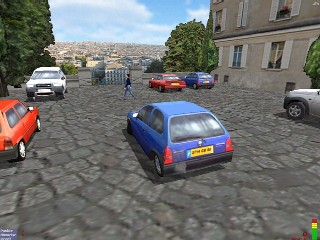 |
|
Physics engines can be purchased from different manufacturers. Several game development systems have an integrated physics engine, but be careful: some systems have 'physics' listed in their features list, but only offer simple acceleration or collision functions.
 Q. What is a Script Compiler? Q. What is a Script Compiler?
A. Many 3D game systems use scripting languages for the gameplay or for controlling objects or actors. The more things move in the game, the more script instructions have to be executed per second. For this reason, a script compiler - such as lite-C - translates the language into machine code, the native language of the processor. This allows program execution at maximum speed.
Many older script languages, such a LUA, Python, Angle Script, Torquescript etc. are interpreted (an euphemism for this is 'byte code compiled'). This means that instructions are first translated into an intermediate code. The processor then interprets the code byte for byte at run time. For this reason, an interpreted language runs about 10 times slower than a compiled language. This does not matter for most applications interpreted languages were intended for, but it certainly matters for the frame rate of games.
 Q. Is it true that I must learn programming for seriously creating games? Q. Is it true that I must learn programming for seriously creating games?
A. Yes - no matter what you've heard otherwise. You can build simple games, like 3D shooters, without any programming. However for realizing unique game ideas and special effects you'll need to describe them by scripts. But don't worry. Even if you've never programmed before, by working through the lite-C tutorial you'll pick it up fast.
 Q. Why C instead of BASIC / LUA / PYTHON...? Q. Why C instead of BASIC / LUA / PYTHON...?
A. For many reasons a C based language is the best suited for programming games.
C code is clearer, shorter and easier to understand than BASIC, and runs much faster than interpreted scripting languages such as LUA or PYTHON. Due to its support of C++ classes, lite-C has direct access to DirectX and Windows API functions, and thus allows programming effects that wouldn't be possible with any other scripting language.
C/C++ is used today for almost all commercial games. Even games with LUA or PYTHON scripting use C/C++ for all complex or time critical areas, such as rendering, physics and effects. Windows and graphics libraries have a C/C++ based interface, and C is also the language used for shader effects. Knowledge of C is essential for all programming jobs in the game industry. You just can't avoid it.
 Q. How often is Gamestudio updated, are the updates free to previous owners, and are they downwards compatible? Q. How often is Gamestudio updated, are the updates free to previous owners, and are they downwards compatible?
A. Major new features are added permanently in frequent free updates. You can follow the schedule for future features on the beta and forecast links on our user forum. Upgrades to new engine generations (A5 -> A6 -> A7 -> A8) are released every couple of years and are not free. All engine updates are compatible to its predecessor, so you don't have to change your scripts when updating.
 Q. How bug-free is Gamestudio, and how stable are the games produced with it? Q. How bug-free is Gamestudio, and how stable are the games produced with it?
A. We are pretty sure that Gamestudio is the most stable and robust game creation tool on the market, and we're going to great efforts for keeping it that way. When developing a game, you really don't want to grapple with software bugs! Our company was the first game development tools manufacturer who received the ISO 9001 certificate for his quality control system. Before a new Gamestudio update is released, it is tested for months by our team of around 100 beta testers. After that, it is uploaded to our forum for a public beta test, which normally involves over 1000 testers. Only then it becomes officially available on our download page.
 Q. Is Gamestudio suited for a 13-year-old? Q. Is Gamestudio suited for a 13-year-old?
A. We don't know the minimum age of our users, but the youngest participant in our game development contests was 12, and the oldest 78. Gamestudio is frequently used in game creation courses for teenagers.
 Q. What was the first commercial game made with Gamestudio? Q. What was the first commercial game made with Gamestudio?
A. he first commercial games were the 3D Hunting series by MacMillan. They were developed shortly after the Gamestudio/A4 release by the end of 1999. The grizzly hunting game was the first Gamestudio multiplayer game.

 Q. What was the game with the most distributed copies so far? Q. What was the game with the most distributed copies so far?
A. Great Clips Racing, an advertising game with 1.5 million produced CDs, developed with Gamestudio by Digital Content. The developer wrote us: "I am doing this all with the commercial edition of your software. Compared to what I paid for it ($199) and what I am getting from it, I am very happy." |
 |
  Q. What was the biggest project ever done with Gamestudio? Q. What was the biggest project ever done with Gamestudio?
A. The biggest project so far (and probably the largest 3D world created ever) was the 3D reconstruction of the German city Quedlinburg for the World Exhibition. On a huge video screen, visitors could walk through the medieval center, and enter buildings, colonnades, towers, and cathedrals.
This ambitious and spectacular project was developed by Procon GmbH and the German Foundation for Protection of Historic Monuments (Stiftung Denkmalschutz). The Quedlinburg old town was created anew on the PC, using over 5000 photographs of historic facades and building interiors. Over 400 detailed buildings were reconstructed. The virtual city covered a walkable area of around two square miles. It was divided into multiple zones which ran on a network of PC servers. |
|
  Q. Which was the most sophisticated Gamestudio project so far? Q. Which was the most sophisticated Gamestudio project so far?
A. The project with the most complex scripts we know of is 3D Driving Academy by Harro Besier. Districts of Paris, London, and Berlin were reconstructed for this project. The most sophisticated part however was the traffic AI. It controlled hundreds of cars, motorcycles, people, and traffic lights. It even verified that the driving student didn't violate the rules - and this with the traffic rules of 6 different countries!
Tthe first version of 3D Driving Academy was developed on the side by only two people in 5 months. Meanwhile version 3 is on the market and successfully distributed in many European countries. More than 250,000 copies of 3D Driving Academy were sold so far in Europe, making it the most successful Gamestudio application ever created. |
|
|
|




